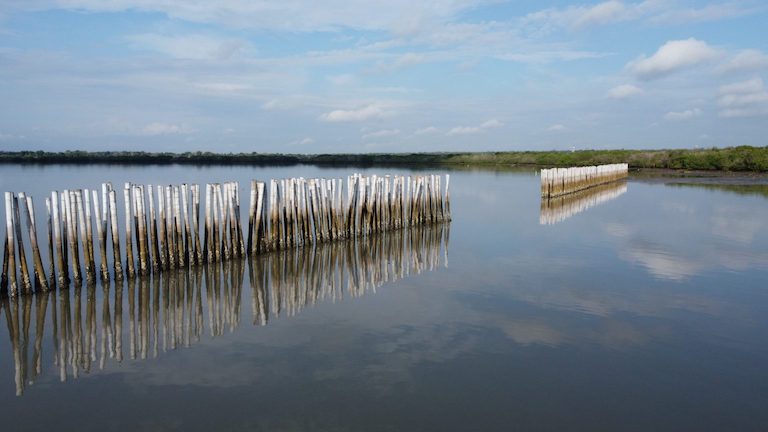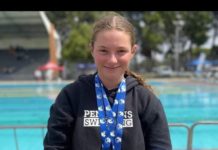- Residents of the Indonesian island of Lombok say sea levels are rising at alarming levels, swallowing seaside towns.
- People are abandoning their family trade of fishing to instead grow seaweed or leave the island for stable employment.
- The provincial government created a climate adaptation task force to address the compounding problems of climate change, as families send their children to school and hope they choose a life different from fishing.
In 2009, a group of Indonesian researchers published a report on the vulnerability to climate change of the eastern Indonesian island of Lombok, home to about 4 million people. Their prediction, based on International Panel on Climate Change Special Report on Emissions Scenarios projections, was that the sea level along the Lombok coast would rise 5-15 centimeters (2-6 inches) by 2020, and 13-35 cm (5-14 in) by 2050. The former is roughly a loaf of sandwich bread, the latter a baguette stood on its head.
The numbers suggest a significant height increase, but they sound staid compared with the reality that is already playing out on the ground. At the end of 2022, Mongabay talked to residents of Lombok’s east and west coasts, and what we heard was alarming.
The ocean is swallowing seaside towns. Fishers are abandoning their family trade, choosing instead to tame small patches of nearshore water with seaweed farms, if not retreat from the beach, and occasionally leaving the Indonesian archipelago completely for stable employment in the Middle East.
Sea level rise is not the only effect of climate change in Lombok’s waters. Global warming is also increasing sea surface temperatures, which is causing the bleaching of shallow water coral and intensifying the storms that erode coastlines. Now, tidal flooding is also more frequent.

The ocean is getting closer
“That used to be my house,” said Mastah, pointing to a patch of the sea surface near Lombok’s eastern shore. A longtime resident of Telindung village, Mastah recalled the town’s previous iteration as a seaside hamlet where locals would gather for an annual sea blessing ceremony, marking the occasion by banging brass gamelan gongs and xylophones. “Folks would come from all over,” she said, recalling a memory and place that today lies underwater.
Tidal flooding was never an anomaly for Telidung residents. The floods were an annual phenomenon. It was normal for seawater to creep into their yards around the New Year. In the 1990s, folks started noticing salt water in their yard more frequently, not just around New Year’s. Then the tides started to enter the houses closest to the sea. In 2002, residents started to relocate their houses to farm plots they owned farther from the coast. Then the ocean swallowed those sites too. In 2008, the district government built a special housing complex for Telindung fishers. That year, the houses at the old village site sank below the sea surface.
Some, like Mastah’s former neighbor Ismail, chose not to move despite pleas from visiting government representatives.
“Moving a house takes money,” Ismail said. This onetime fisherman retains his abode, which now sits precipitously on a seaside cliff. Ismail has detached his work from this unstable environment, traveling instead to Malaysia for stints as a migrant laborer.

When Plan B becomes Plan A
Fifty miles away, on the west coast of Lombok, fisher families in Ampenan, a coastal suburb of the island’s sole city of Mataram, are faced with similar conditions. The coastline is eroding. Ocean storms are getting fiercer. Increasingly, villagers are opting to mine sand or do odd jobs instead of fish. Similar to Ismail, many are now migrant laborers. The men mostly go to Malaysia, the women to Saudi Arabia.
“Right now the sea water is getting closer but the fish are farther away,” said Nurhayati, the wife of an Ampenan fisherman. She has already returned from a stint in Saudi Arabia.
“It’s getting harder to be a fisherman now,” said Bahri, from Teluk Kombal village, which is also experiencing erosion on its coastline. “All materials are expensive, fishing grounds are farther, the results are few.”
Some fishing villages have adapted by reducing hours spent at sea fishing to invest time into seaweed cultivation near the shoreline.
Senam is a fisherman-turned-seaweed-cultivator living and operating in Seriwe village in southeast Lombok. Seaweed has long been cultivated in his village, which is so remote it does not have a source of fresh water.
In the 1990s, many cultivated seaweed as a side activity, something to busy themselves and generate income during the stormy winter monsoon season when they could not go to sea to fish. The economic and natural environment around Seriwe shifted though. The fishing grounds got farther away; at the same time the demand for seaweed increased. By the year 2000, more joined. Between 2008 and 2014, Seriwe became renowned on the island as one of Lombok’s largest seaweed cultivation centers.

For younger fishers in the village today, seaweed is the main source of income and fishing is a side activity. One young Seriwe cultivator, Hasyim, even noted that the village moves to a new seasonal calendar. In the rainy season, fishers plant green seaweed, and during the windy winter monsoon season they plant brown seaweed.
“We plant corn [on land], then we wait for it to rain once before planting seaweed [in the nearshore waters],” Hasyim explained. “If you plant when you just fertilize [on land] and it rains, the rain water gets filled with fertilizer. The results are not good for the seaweed.”
The threshold for entry into seaweed cultivation is expensive, though, and not all can join. Rafts need to be built. Crops can fail.
Can policy abate pain? Or correct course?
Though locals might not name it, climate adaptation is utmost in many minds.
The government is trying to help. The fisheries ministry has built wave barriers out of bamboo at various sites on Lombok. In 2007, the government of West Nusa Tenggara province became Indonesia’s first to create a climate adaptation taskforce in response to the national climate adaptation plan (RAN-MAPI). In 2008, it set up a One-Stop Services program in Mataram to expedite the processing of travel documents for migrant workers. In 2018, it set up another five centers in Lombok.
However, the anecdotes are adding up to a portrait of many in a difficult situation feeling unaided, or needing to course correct.
“Thankfully the government has given educational scholarships to my children,” said Salib, an elderly fisherman from the sea-facing Bintaro neighborhood of Mataram city. Salib used to park his boat far from the houses in his quarter, past a field where children played, past pandan palms lining the river delta. Bank erosion has since brought his boat parking right into his yard. When the tidal floods come now, seawater enters the house, leaving sand behind. The walls of his once high-ceilinged rooms get shorter every year. Now he steps down from the yard to enter the house.
“I hope [my children] don’t become fishermen,” Salib said.
Banner image: Traditional fishing boats on a Lombok beach. Image by Graham Crumb via Wikimedia Commons (CC BY-SA 3.0).
This story was first reported by Mongabay’s Indonesia team and published here on our Indonesian site on Sept. 17, 2022.
Related reading: In Sumatra, rising seas and sinking land spell hard times for fishers
Citations:
Suroso, D., Hadi, T. W., Sofian, I., Latief, H., Abdurahman, O., Julianto, H., & Setiawan, B. (2009). Vulnerability of Small Islands to Climate Change in Indonesia: A Case Study of Lombok Island, Province of Nusa Tenggara Barat. Retrieved from International Conference on Climate Change Impacts on Water Resources and Coastal Management in Developing Countries website: https://www.researchgate.net/publication/301283888_VULNERABILITY_OF_SMALL_ISLANDS_TO_CLIMATE_CHANGE_IN_INDONESIA_A_case_study_of_Lombok_Island_Province_of_Nusa_Tenggara_Barat
Fitranita, F., Latifa, A., Setiawan, B., & Noveria, M. (2021, April). Migration management to reduce the risk of climate change: government perspective. Paper presented at The 1st Universitas Lampung International Conference on Science, Technology and Environment, Lampung. Retrieved from https://www.researchgate.net/publication/351108374_Migration_management_to_reduce_the_risk_of_climate_change_government_perspective
This story first appeared on Mongabay
South Africa Today – Environment
This article is licensed under a Creative Commons Attribution-NoDerivatives 4.0 International License.
You may republish this article, so long as you credit the authors and Mongabay, and do not change the text. Please include a link back to the original article.












